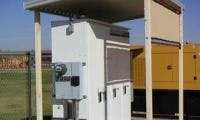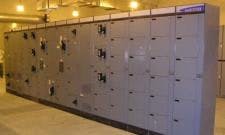By Bob Moreno, Electronics Technician for the City of Yuma
Motor Control
The city of Yuma is tucked in the Arizona desert near the state’s borders with Mexico and California. It is the nation’s third-fastest-growing area, and over the past decade, Yuma’s population has grown more than 50%, with no signs of slowing down.
Yuma’s population doubles in winter as retirees and visitors flock to the warm climate. Explosive growth has placed tremendous demands on the city’s ability to reliably and efficiently collect up to eight million gallons of sewage per day through its wastewater collection system.
In 1985, Yuma installed a proprietary SCADA system to control and monitor its water and wastewater distribution system remotely. But as the city expanded, it became clear that the existing SCADA system lacked the needed support, performance and diagnostic capabilities.
A typical remote water pump station site with an MCC, a control panel and a generator all installed outdoors.
Because the SCADA system lacked the functionality to monitor individual lift station pumps in outlying areas remotely, operators were not alerted to pump malfunctions. They would instead often learn about pump problems from residents’ phone calls or when they were found during scheduled pump station visits.
Upgrades were difficult and costly because the system was proprietary. Those of us working on the systems were often forced to contract outside support services for routine maintenance and repairs at a cost of up to $5,000 or more per visit. As the system aged, these visits were becoming more frequent, usually once a month for each of more than 20 sites. Quick access to replacement parts was also an issue, with spares often taking more than a month to arrive.
The outdated SCADA system also made it difficult for the City of Yuma to meet increasingly stringent environmental regulations, and violations could have resulted in hefty fines.
Changes Needed
Our consulting engineers, our internal project management and our operational staff all knew that we needed a new SCADA system that was easy to use, scalable, reliable and more cost-effective than the existing one. We wanted a system that plant operators could configure and monitor over a network. Finally, the system had to be supportable with our own internal resources so we wouldn’t have to rely on outside contractors.
The new system needed to accommodate additional pumping stations to meet Yuma’s expected residential and industrial growth. Reliable monitoring capabilities were critical to maintain regulatory compliance, and we needed to keep operational and support costs low to stay within a tight municipal budget.
A key feature needed for the new system was the ability to help operators avoid delays in wastewater service. We also needed a responsive and dependable control system vendor that could supply spare parts quickly and troubleshoot system problems efficiently.
We worked with Yuma-based OneSource Distributors and teamed with Rockwell Automation to develop a control system to meet our needs. Critical to success was developing a SCADA system that remotely monitored all outlying stations from the central control room at the main treatment plant.
“Some of our pumping and lift stations are more than 11 miles from the main plant,” says Arlen Ritter, a senior operator with the City of Yuma. “We needed a networked system so we’d know exactly where to send maintenance personnel to investigate or repair a problem. We also wanted remote alerts to eliminate the need for wastewater personnel monitoring pump stations 24 hours a day.”
We now have 26 remote sites, each equipped with an Allen-Bradley Intellicenter MCC (www.rockwellautomation.com). MCC motor control includes E3 Plus solid-state relays networked to a local PLC via DeviceNet. Of the 26 remote sites, five are main wastewater pumping stations, and each of these has an SLC 500 PLC acting as the remote terminal unit (RTU). The 21 remote water pump stations each have a SLC 5/03 RTU.
The City of Yuma’s main wastewater pumping station motors are controlled and monitored by multi-section MCCs. The motor control circuit solid state relays are linked to a local RTU PLC via DeviceNet.
In both cases, the RTU PLC talks to the solid-state motor control relays via DeviceNet. This high-speed digital link allows us to monitor pump motor amperage, elapsed pump motor runtimes and several pump motor fault conditions.
At the main control room, we installed an RSView Human Machine Interface (HMI) to remotely control and monitor the remote sites. We have RSView running on a two screens, one 21" and the other 42".
Communications between the main control room and each of the 26 remote sites is via a licensed radio frequency. Each RTU is linked to its remote radio via an RS-232 link, and the RSView HMI stations are also linked to the home base radio via RS-232.
Money Saved, Improvements Made
We installed the new SCADA system for about $245,000, half the installed cost of the old system. The new SCADA system monitors and reports individual pump status and other critical operational parameters to one central location. This saves us up to $100,000 a year in labor because we don’t have to routinely send plant personnel to each remote site.
The new networked system also helped eliminate proprietary system troubleshooting expenses. Access to parts and service was improved because the new system is based on open standards with local support.
“The old system required personnel to frequently be on-site monitoring the pumps,” observes Ritter. “Now that the system is completely networked, we receive an alarm in the main control room if amperage in one pump controller is too high, and we can go directly to the problem and fix it. In some instances, the system’s predictive monitoring helps us address over-amperage problems before faults occur.”
Predictive maintenance is implemented by monitoring pump starts, pump stops and pump motor amperage. After a preset number of starts, an operator is alerted to write up a work order for an electrician to perform a field inspection. After the field inspection, the operator resets the pump start counter at the HMI.
The system also alerts operators after a certain number of runtime hours for each pump motor. A work order is then written for the mechanical staff to pull the pump for cleaning and inspection. Run-time hours are reset after inspection.
The HMI is used to create a history for each remote site. This lets us see variations in flows and pump failures and correlate this data against pump starts, pump run-time hours and pump motor high-amperage alarms. Data analysis lets us set pump monitoring parameters accordingly to prevent failures.
Monitoring discrete parameters also aids field personnel. “Monitoring pump on/off status along with pump hand-off-auto status can prevent potential problems if someone working at the site accidentally leaves the pump in manual,” according to Ritter.
The new MCCs performed so well in the wastewater pumping stations that they are now standard in our wastewater system design specifications. Smart MCCs are ideal for the city’s wastewater treatment system because they provide the diagnostic information that we need to keep the system running.
We saved at least $12,000 annually due to the local support provided by the distributor. Local distribution can deliver replacement parts in one or two days as opposed to several weeks with the old system. This has significantly increased uptime.
“When a station goes down, we need it fixed as soon as possible,” stresses Ritter. “We can’t tell someone not to use his or her water for a few weeks because we’re waiting on a new part.”
Perhaps the greatest savings has been in avoiding unnecessary costs. When the networked system sounds an alarm to indicate that a station is operating outside of its parameters, it alerts operators who can send out a mechanical or electrical staff member to repair potential problems before a station shuts down.
This networked alarming capability helps us comply with environmental regulations because we can identify and prevent pump malfunctions that might cause wastewater to be accidentally released into a residential or environmentally restricted area. Such offenses could cost us up to several hundred thousand dollars per offense. “The new system gives us confidence that we’ll never have to deal with environmental offenses,” says Ritter. “Its networked design keeps us informed of potential problems so we can fix them before anything severe happens.”
“We view the installation as a complete success,” concludes Ritter. “We’ve cut costs, have a more reliable system, and we can do the majority of work ourselves.”
Problems with Old Proprietary SCADA System
- Outside contractor needed for routine repairs and maintenance
- Spare parts not readily available
- Difficulty effectively monitoring remote sites
- Upgrades difficult and costly
- Difficulty meeting environmental requirements
Table 1: Problems with Old Proprietary SCADA System
1) Outside contractors needed for routine repairs and maintenance |
2) Spare parts not readily available |
3) Remote sites could not be effectively monitored |
4) Upgrades difficult and costly |
5) Difficult to meet environmental requirements |
Table 2: Advantages of New SCADA System
1) System uptime increased by real-time monitoring and control |
2) System can be supported with in-house personnel |
3) Site visits much less frequent because of remote monitoring |
4) Spare parts stocked by local distributor |
5) Extensive diagnostic information allows predictive maintenance |
Advantages of New SCADA System
- System uptime increased by real-time monitoring and control
- System supported by in-house personnel
- Less frequent site visits because of remote monitoring
- Spare parts stocked by local distributor
- Extensive diagnostic information enables predictive maintenance

Leaders relevant to this article:





